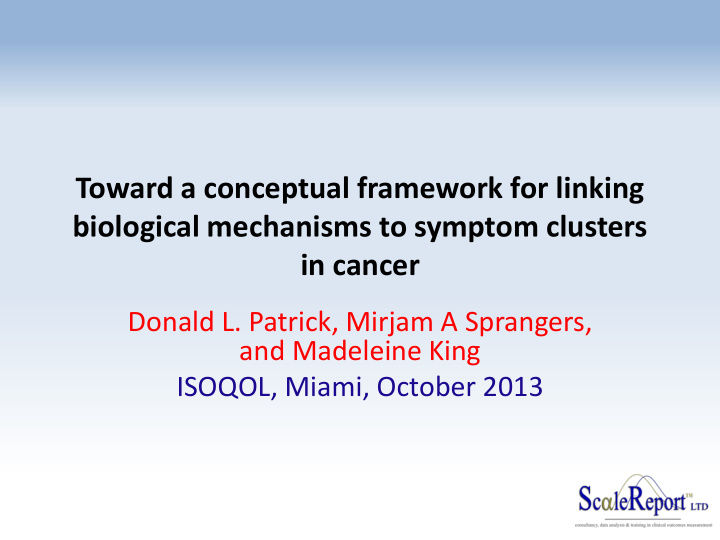



Toward a conceptual framework for linking biological mechanisms to symptom clusters in cancer Donald L. Patrick, Mirjam A Sprangers, and Madeleine King ISOQOL, Miami, October 2013
Sprangers et. al Qual Life Res (2010) 19:1395–1403 Encyclopedia of Quality of Life (Forthcoming) Based on Wilson and Cleary (1995) Molecular and genetic factors Characteristics of the individual E.g., Extraversion, loneliness, sociability Biological and Symptom status Functional physiological status variables Somatic E.g., Fatigue, pain, Molecular General Overall malfunction reduced mobility Social and genetic health quality of functioning factors perceptions life E.g., Mood disturbance, CNS communication malfunction impairment, social fear Characteristics of the environment E.g., Social support, family structure, neighborhood
S.K. Lutgendorf, E.S. Costanzo / Brain, Behavior, and Immunity 17 (2003) 225–232
Genetics, Epigenetics and Pain • Why do some people experience pain differently from other people? – Emerging data offer convergent evidence for the importance of ion channels in both pain sensitivity in normal populations and pathological pain states – Research suggests a SNP within the SCN9A gene that encodes the α subunit of the voltage gated sodium channel Na V 1.7 may play a role in determining risk for chronic pain conditions as well as variation in pain responding within normal populations. [91] In a mixed cohort of sciatica, osteoarthritis, pancreatitis • Why do some people get pain relief from a treatment and others do not?
Pro-inflammatory Pathway I L-1 β Fatigue x5 Pain Depression Anti-depressant response General health Physical function
Anti-inflammatory Pathway Fatigue Pain Depression Social function General health Physical function
Dopaminergic Synapse Fatigue Pain Emotional function: Positive affect Social function
Amygdala and Neural Pathway
So what might help us put it together? • Make advances helped by blurring research boundaries and using multi and trans disciplinary perspectives • Examine pathways by placing questions on a theoretical modelssuch as Sprangers et al expansion of Wilson and Cleary or Lutgendorf as starting point • Include important modifiers or confounders such as resilience and personality • Add each subjective domain as a correlate individually or together in clusters, i.e., pain, depression, fatigue
PRO Measurement in the Pathways • Use symptom and sign measures with clear concept and dimensionality • Consider measures of personality and resilience (assessed with PROS or ?) --Strengths and Difficulties Questionnaire for Infants and Youth • • --Measures of Coping • --Optimism Pessimism • --Cognitive Reserve • Measures of impact more distal but related • --Functional status • --Perceived quality of life
Cautionary Thoughts • Missing heritability – Even when dozens of genes linked to a trait or behavior, cumulative effects disappointingly small – No surprise it isn’t one gene, one phenotype but more complex – Possibly 1000s of variants – GWAS and SNPS– to sequencing whole genomes • Brain “plasticity” --brain changes with experience • We can move along with basic science
Other challenges • Difficulties of causal inference even with personalized risk profiles using genetics • Findings “need” to be placed within structural determinants of population and individual health—the social patterning of health and illness • Need for use of innovative research designs such regression discontinuity design, pretest post-test with thresholds
Recommend
More recommend